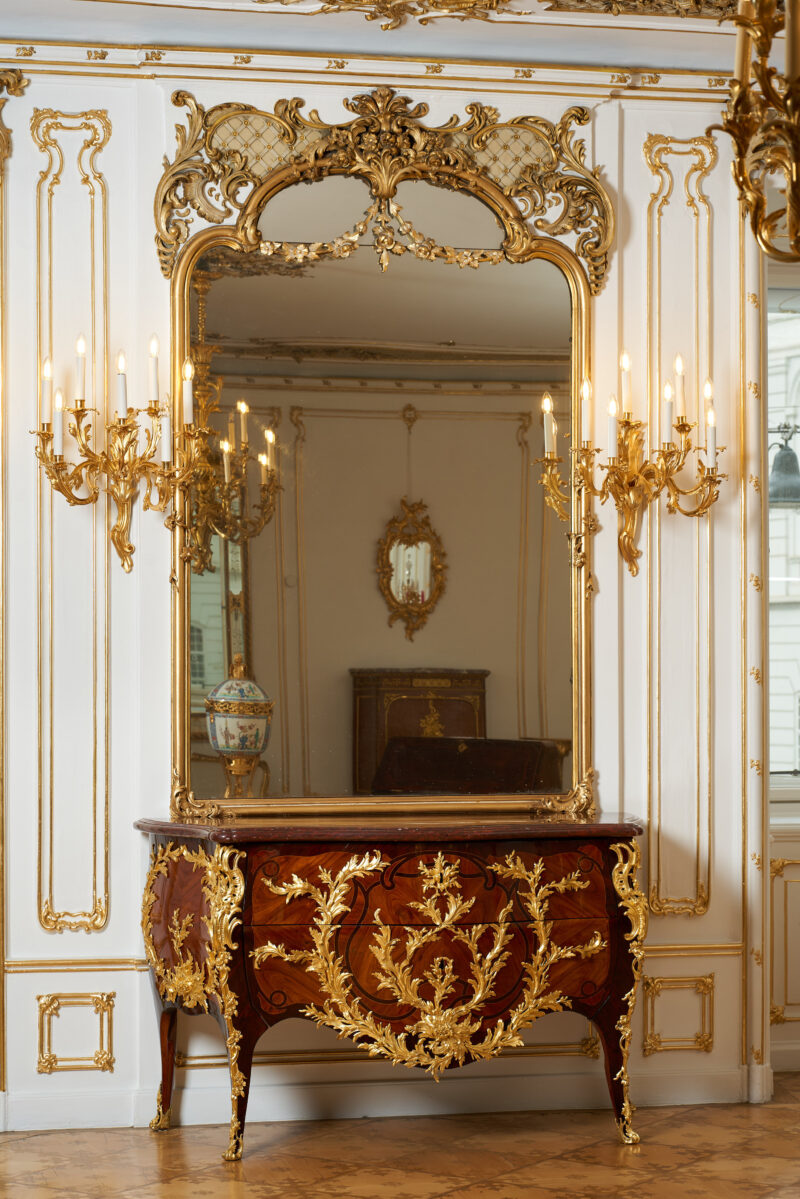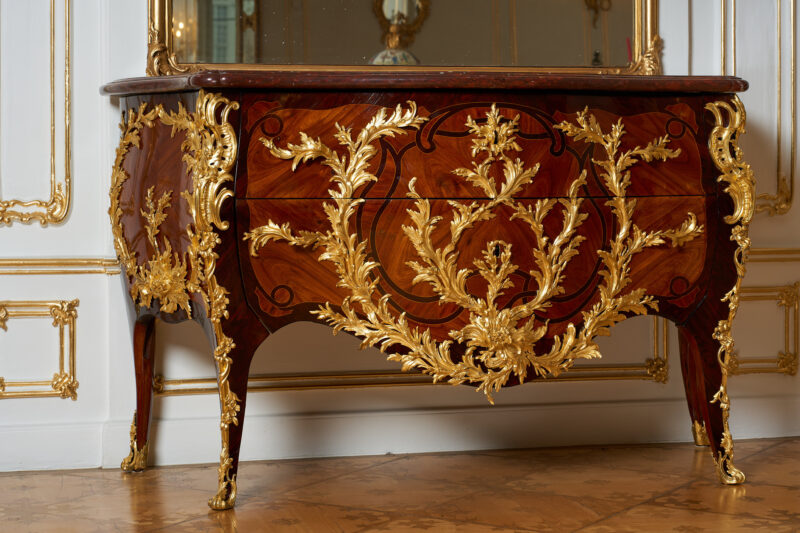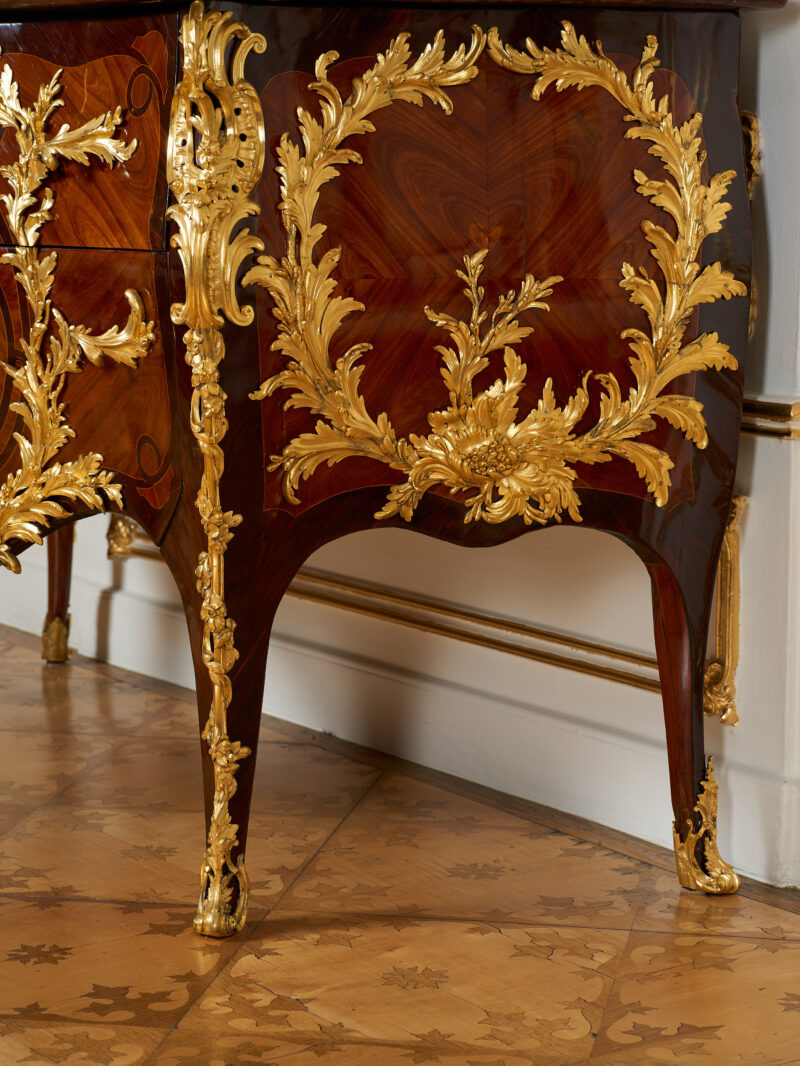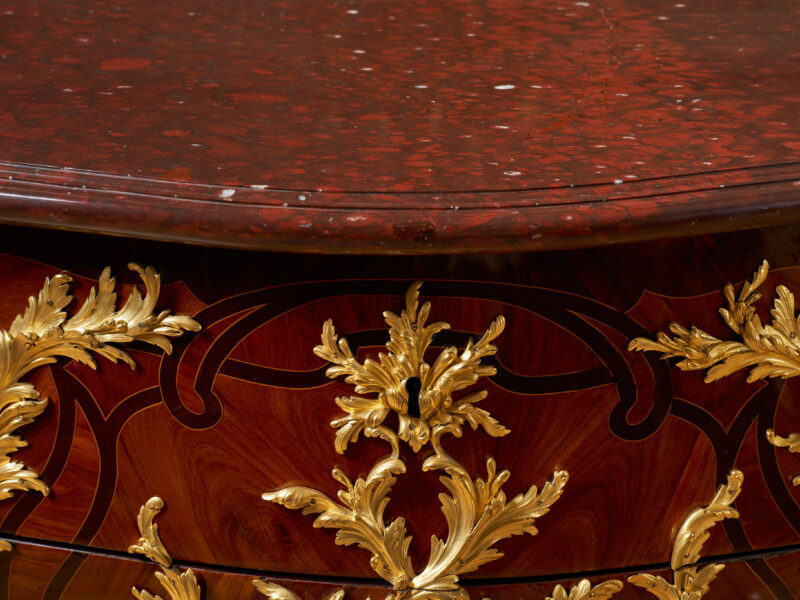
Magnificent Large Salon Commode from the renowned workshop of the cabinetmaker Pierre Roussel
This large and extraordinarily executed Commode was crafted in Paris around 1750 by the renowned cabinetmaker Pierre Roussel (1723 — 1782). The piece features two large drawers made with sans travers, as well as a moulded marble top following the contours of the furniture, crafted from red Griotte marble.
This marble was a favorite of Louis XIV and was extensively used in all of his properties. The oak body is finely veneered with violet or kingwood and rosewood. The term “kingwood” originated because French kings (including Louis XIV and Louis XV) greatly valued the wood for making noble furniture in the 17th and 18th centuries. The front is beautifully ornamented in Roussel’s typical curved form with band and string inlays, over which the magnificent gilded bronze hardware is adorned.
The square legs, slightly flared and transitioning into slightly advanced, angled pilasters or front stiles, are decorated with gilded bronze fittings in the form of flowers, foliage, and rocaille shapes.
The two large drawers are richly decorated with garlands of acanthus foliage, which encompass both the keyholes and the four drawer handles, converging in a highly elaborate element of foliage and berries in the lower center. The two sides of the splendid commode are similarly adorned with elaborate gilded bronze fittings. Here too, the veneer is mirrored in butterfly form, worked with string inlays and a surrounding frieze.
The piece captivates with both its masterful and characteristic Roussel veneer and inlay work, as well as its magnificent, finely chiseled gilded bronze hardware.
Stamp on the right front stile under the top: P. Roussel, as well as guild stamp JME (Jurande des Menuisiers-Ébenistes) shield with monogram BTF and rank crown in a frame on the back, as well as a large painted B also on the back.
Pierre Roussel (1723 — June 7, 1782) was one of the prominent cabinetmakers of the Roussel dynasty. His father was a simple journeyman who worked for a master cabinetmaker. Four of Roussel’s brothers were menuisiers (carpenters) and worked on carved seating furniture and room paneling. Roussel opened a workshop on Rue de Charinton in Paris. His beginnings were modest, but through diligence and business acumen, he developed into one of the most sought-after and talented cabinetmakers of his time.
Roussel crafted a variety of furniture in a wide range of types and styles, with detailed marquetry and gilded bronze fittings of excellent quality. He married Marie-Antoinette Fontaine in 1743 and received his master’s title on August 21, 1745, being received as a master cabinetmaker by the Paris guild. In 1762 and 1780, he was appointed a juré (member of the jury) and held other positions in the Corporation des Menuisiers-Ébenistes. He received support in his extensive business from his two sons, Pierre-Michel (master in 1766) and Pierre le Jeune (master in 1771).
The contemporary “Almanach d’indication générale ou du Vray mérite” highlighted him in 1768 as one of the most prominent cabinetmakers of his time in Paris (Kiellberg, p. 729). Pierre Roussel had many patrons and significant clients. One of his biggest patrons was the Prince de Condé, who made considerable purchases from Roussel between 1775 and 1780 for the Palais Bourbon and the Château de Chantilly. In addition to Louis Joseph De Bourbon, Huitième Prince De Conde, the list of names of his clients reads like a small who’s who of his time.
Among them are personalities such as:
Louise Mathilde d’Orléans Duchess of Bourbon, Versailles, Château de Versailles et de Trianon, Louis Jean Marie de Bourbon Duc de Penthièvre, Louise Félicitè Victoire d’Amont Princess de Monaco, Anne David Sophie Cromot De Fougy, Pierre-Charles Bonnefoy Du Plan (custodian of the Queen’s furniture), concierge of Queen Marie Antoinette at the Petit Trianon. From March 17, 1789, he also served as the king’s secretary.
During the trial against Marie Antoinette, he spent fifteen months in prison, from which he was only released after the death of Robespierre. Pierre Roussel received, among many others, significant orders from the Le Garde-Meuble De La Couronne (Crown Furniture Storage) and Les Menus-Plaisirs (entertainment offices of the court), to name a few.
The largest museums today preserve furniture by Pierre Roussel, including:
M.A.D. Museum of Arts and Design NY, Louis — Saint Louis Art Museum, Louvre Paris, Petit Palais, Waddesdon Manor, Collection Versailles, Château de Versailles et de Trianon, and many more.
Further collections and literature:
André Boutemy’s assessment at the article on Adrien Delorme
Francis J.B. Watson, “The Wrightsman Collection”: Furniture, Gilt Bronzes and Mounted Porcelain, 1966:557f (brief biographical notice)
Samuel H. Kress Collection at the Metropolitan Museum of Art
The James A. de Rothschild Collection at Waddesdon Manor: II. Furniture, Clocks and Gilt Bronze
Comte François de Salverte, “Les ébénistes du xviiie siècle”, 1927, s.v. “Roussel, Pierre“
Les Roussel une Dynastie d’Ébénistes au XVIII Siècle
Pierre Kjellberg: Le Mobilier Français du XVIIIe Siècle, Paris 2008, p. 766 – 775
Red Griotte marble:
This particular marble received its name from the Morello cherry, which is called Griotte in French and has an incomparably intense red color.
Often the red Griotte contains numerous goniatite fossil shells filled with white calcite, then it is called “oeil de perdrix” (partridge eye).
Griotte red was one of King Louis XIV’s favorite marbles and was extensively used in the royal apartments in the 18th century. This wonderful red stone was used, for example, in the production of sculptures, magnificent clocks, and for the interior decoration of churches, castles, and palaces, such as in the Hôtel de Cassini (1768), where the dining room was decorated with Griotte marble. Many of the fireplaces in the Palace of Versailles were also ordered from red Griotte marble by Louis XIV. For Louis XV’s cabinet, a fireplace without bronzes from this marble was ordered early on, which can still be seen today.
We find many other fireplaces made of red Griotte marble, mostly with gilt bronzes, in Louis XVI’s wardrobe cabinet, in the study, in the council chamber, as well as in the apartments of Marie-Antoinette and Madame Victoire, in the Château de Fontainebleau, and in the Louvre, to name just a few. At the beginning of the 19th century, the Arc de Triomphe du Carrousel was made from this marble on the orders of Napoléon Bonaparte in 1809, which was intended to give it a particularly imposing appearance.
Also in the Opéra Garnier in Paris, we find in the Grand Foyer a monumental fireplace made of this wonderful red marble.
The main quarries are located in the regions of Caunes-Minervois and Félines-Minervois, northeast of Carcassonne. Exploited already in antiquity, they were rediscovered around 1615 by the Italian sculptors Stefano Sormano and Antoine Lignani, who began trading Canes marbles in exchange for white Carrara marble. The famous sculptor Bernini drew the king’s attention to these quarries, Claude-Félix Tarlé ordered them to be exploited for the court, and then they were declared “Royal Quarries” in 1692.





